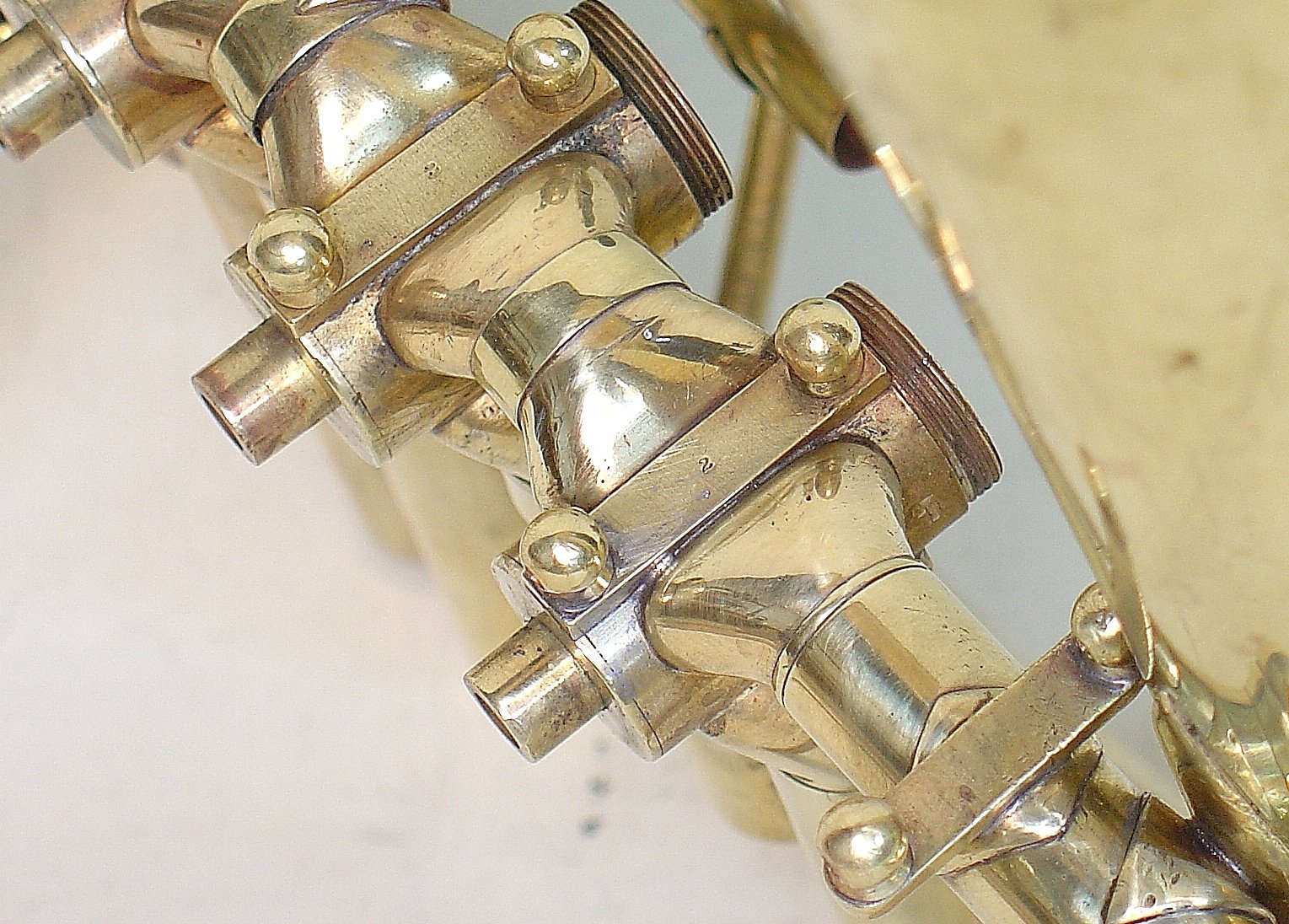Circular Cornet with Four Valves by Benjamin Franklin Richardson
This interesting little cornet was made in 1855, while B.F. Richardson had his shop at 19 Washington St in Boston. It is pitched in C when the short, straight mouthpipe shank is used and lowered to Bb with the circular crook shown in the third photo. The fourth valve is obviously a whole step, being approximately the same length as the first, but notice that it is very slightly shorter. When actuated, it raises the pitch by a whole step to D or C. This gives the player easy trills from all notes and perhaps some alternate fingerings for intonation, although I find the latter less convenient than descending fourth valves. It may make more sense to players accustomed to "clapper keys" as seen on early English cornets, which also raise the pitch by approximately a whole step.
Click on an image below for larger views.
The idea of an ascending valve in a soprano instrument was re-invented in the late 19th century by Merri Franquin and manufactured by Jerome Thibouville-Lamy. This cornet was built early in Richardson's career, having started working in J.L. Allen's workshop only three years before. It exhibits a very high quality of workmanship, especially considering this fact and being made during early, formative years for the industry in the US. A more thorough presentation of Richardson's history can be read on my page featuring a bell front cornet.
Also interesting is to compare the bore profile with later Boston made Bb and C cornets. Those made after the late 1850s are very close copies of the cornets introduced by the French makers Courtois and Besson several years earlier. Earlier American cornets such as this, Richardson's Bb cornet and Fiske's circular cornet featured elsewhere on this site, have very short mouthpipes leading into a fairly small bore valve section and end with wider bell flares. It would appear that these earlier US made cornets were influenced more by early English cornets (cornopeans) and, perhaps, German band trumpets, before the influence of the French cornets was fully felt.
In 1853 and 1854, the famous touring orchestra of Louis Jullien came to America, playing concerts, mostly in New York, but some in Boston. The famous cornet soloist, Hermann Koenig was heard by tens of thousands of Americans, playing his Courtois Bb cornet, stimulating a demand for such instruments here. Jullien was the London dealer for Courtois instruments and traveling with him was S. Arthur Chappel, who later took over this business. They were supplying these cornets through New York dealer Edward Hopkins some time later.
It is well known that small brass instrument makers have always purchased various parts and assemblies from other makers. This is still the case today, including purchases ranging from minor small parts to complete instruments. I have no way of knowing what B.F. Richardson did or didn't make, but there is clear evidence in this instrument of parts made by different makers. All the known instruments by Richardson have these distinct flat windway valves with the caps allowing removal of the rotor on the opposite side from where the valve is actuated. In all of these instruments the valve parts are numbered with tally marks or Roman numerals indicating all the parts for each valve as seen in the fourth photo. The next two photos show the levers and saddles that are stamped with tiny Arabic numbers, clearly by a different maker than made the rotary assemblies.
The next photo below was taken during restoration and shows the tubing that enters and exits the valve casings. On the left is where the mouthpipe connects and the right is where the first valve connects to the second valve. In the latter case, the tubing never becomes completely round, but rather connects with an oval shaped ferrule. This differs from valves made in the Allen, Hall and Quinby shops in which these connections are all round even though the flattened connection to the casing is longer and thinner. The bore measured in the valve slides is .434" and the bell diameter is 5 1/16".
The last photo was take as acquired, before restoration. The known history of this cornet starts in the mid-1980s when it was purchased at a yard sale in New Hampshire for $1 and given to the previous owner who is a trumpet player. It was missing the original shank for C, although the Bb crook appears to be original. The mouthpiece is not likely original with the cornet, but works well and appears to have been used with it during the original period of use.








